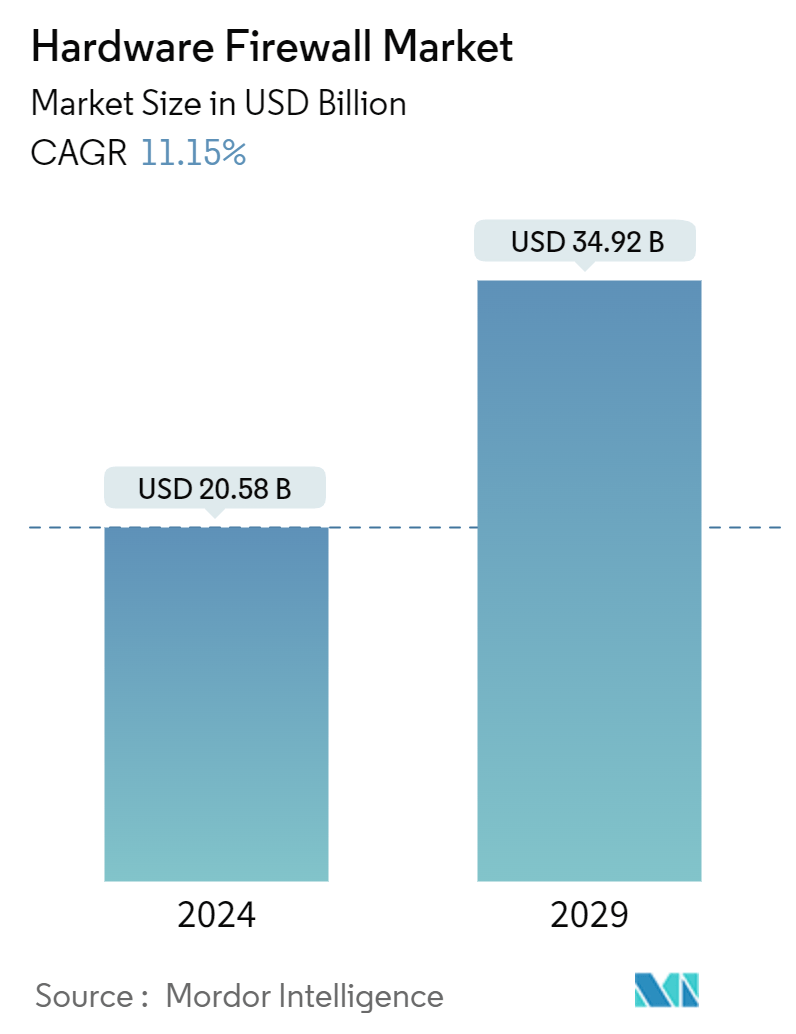
| Study Period | 2019 - 2029 |
| Market Size (2024) | USD 20.58 Billion |
| Market Size (2029) | USD 34.92 Billion |
| CAGR (2024 - 2029) | 11.15 % |
| Fastest Growing Market | Asia Pacific |
| Largest Market | North America |
| Market Concentration | Low |
Major Players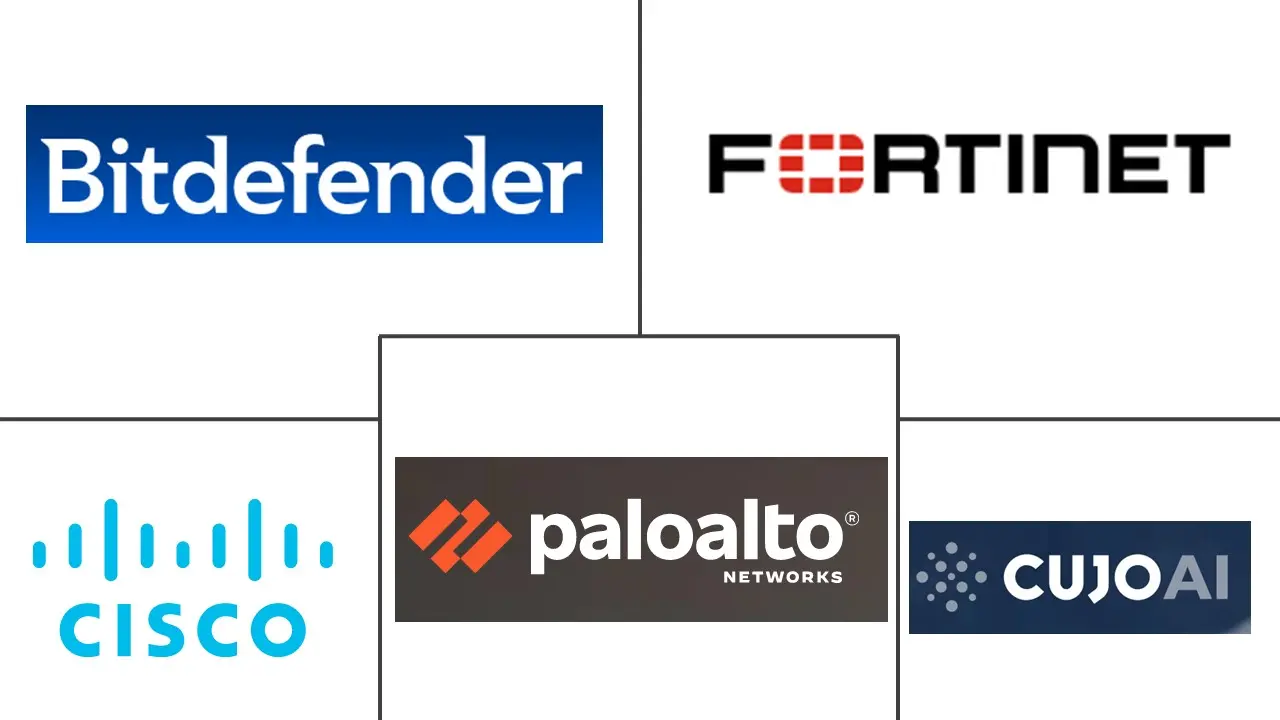
*Disclaimer: Major Players sorted in no particular order |
Hardware Firewall Market Analysis
The Hardware Firewall Market size is estimated at USD 20.58 billion in 2024, and is expected to reach USD 34.92 billion by 2029, growing at a CAGR of 11.15% during the forecast period (2024-2029).
Cybersecurity threats increase the risk of cyberattacks, which can breach the systems of another organization or an individual. The attacker’s motives are to access information for financial gain. Such attacks raise concerns about infrastructure safety, increasing the demand for hardware firewalls.
- Hardware firewalls are anticipated to remain an important component of enterprises' and organizations' cybersecurity strategies as they adopt newer technologies and extend their digital presence. The future growth of the hardware firewall market will most likely be driven by various factors, such as increased network security threats, the growth of cloud-based services, the expansion of IoT, and the demand for more sophisticated security solutions.
- The IT and telecom segment held a substantial market share by industry. Due to the increasing reliance on digital communication and data transmission, the future of IT and telecom employing hardware firewalls is expected to witness technological advancements and a greater emphasis on security.
- The demand for cloud-based firewall solutions is rising, especially in large organizations that deploy cloud platforms for network security. The financial sectors experience a need for cyber fraud prevention and security measures due to significant cyber threats. Additionally, advancements in performance, threat identification and mitigation capabilities, cloud integration, interaction with other security technologies, and automation are projected to drive the hardware firewall market.
- Increased cloud data breaches and the growth of NGFW (next-generation firewall) across devices are boosting the demand for firewalls as service solutions, which act as a market constraint. Since there is no hardware involved in this service, maintenance is quick. Unlike a hardware-powered firewall, a firewall as a service does not require complex configuration. A hardware firewall is more expensive than a software firewall since an initial investment depends on the degree of protection. As a result, this factor is expected to act as a growth catalyst for the firewalls-as-a-service industry.
- Post the COVID-19 pandemic, global enterprises have been facing an increasing number of attacks on their networks, leading to an increase in investments in safeguarding networks worldwide. A significant share of the IT hardware investment in the network is expected to be focused on enhancing security. Over the forecast period, network security equipment like firewalls may become a key part of enterprise IT spending worldwide.
Hardware Firewall Market Trends
Healthcare Industry is Expected to be the Fastest-growing End User
- Over the past few years, the healthcare industry has become a target of significant interest among cybercriminals. Due to its generation of valuable data, healthcare has recently become vulnerable to cyber-attacks. As per a HIPAA Journal report, healthcare institutions reported 725 data breaches, of which more than 133 million records were under ‘exposed risk’ in 2023. The report also stated that the healthcare industry reported a 239% exponential rise in hacking-related data breaches from January 2018 to September 30, 2023, and a 278% rise in ransomware attacks during the same period.
- Post the COVID-19 outbreak, hackers vastly evolved their tactics to exploit the fears escalating among the population, spurring the need to adopt cybersecurity practices to keep pace with changing threats, especially in healthcare. For instance, in March 2023, Fujitsu announced the launch of a new cloud-based platform that allowed users to collect data safely to promote digital transformation in the healthcare domain. The company planned to offer a new platform to pharmaceutical and medical companies in Japan starting in March 2023. The platform ensures the automatic conversion of medical data from the medical records of medical institutions to regulate with the standards framework (HL7 FHIR) and ensure the safety of documents.
- Various collaborations have been taking place in the industry following a public call asking governments worldwide to join forces with the private sector and academia to ensure that medical facilities are protected from cyber threats. For instance, in October 2023, the Cybersecurity and Infrastructure Security Agency (CISA) and the Department of Health and Human Services (HHS) announced a roundtable regarding the cybersecurity challenges that the US healthcare and public health (HPH) sector experiences. They released a cybersecurity toolkit and customized resources for the healthcare and public health sectors. This discussion provided suggestions around cybersecurity and privacy risk management activities.
- As part of their ongoing efforts to help organizations prevent cyberattacks, the US Federal Bureau of Investigation (FBI), the Signals Directorate’s Australian Cyber Security Centre (ASD’s ACSC), and the Cybersecurity and Infrastructure Security Agency (CISA) announced a collaboration to release the joint Cybersecurity Advisory (CSA) in December 2023. A growing number of incidents are being registered across the world. For instance, the first Play ransomware incident in Australia was observed in April 2023 and then in November 2023. The advisory recommended executing a recovery plan to maintain the multiple copies of sensitive data in a physical, separate, and secure location. It also suggested having time-based access to highly sensitive data and maintaining offline data backup that is encrypted and immutable.
- Many organizations are becoming more aware of planned investments in cybersecurity infrastructure. For instance, as per a survey conducted by the HIMSS Healthcare Cybersecurity, respondents suggested an increase in healthcare cybersecurity budgets (by around 55.31%), while other respondents suggested their budgets stayed the same (23.46%).
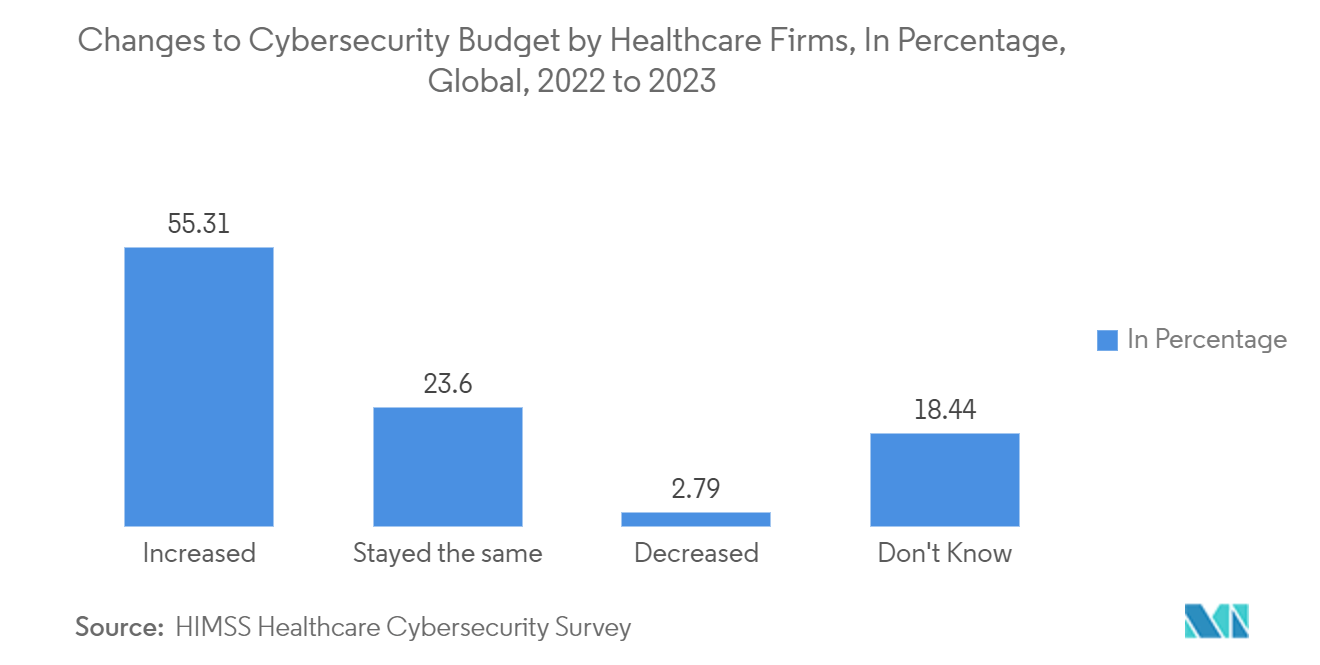
North America is Expected to Hold a Major Market Share
- North America is one of the most technologically developed regions. The growing adoption of technology is expected to result in important changes in the region in the coming years. Some key technological advancements that have the prime potential to alter civilization include robotics, sensor technology, Big Data, and artificial intelligence, resulting in a vast amount of data generation that further needs enhanced data security.
- In recent years, cybersecurity has become an increasingly important area of focus in the United States due to a surge in the total count of cyber threats and attacks faced by organizations and individuals. As per the Identity Theft Resource Center, in 2023, the total number of data compromises in the United States stood at around 3,205 cases. Meanwhile, in 2023, over 353 million individuals were greatly affected by data compromises, including leakage, data breaches, and exposure.
- The market is witnessing mergers, acquisitions, and investments by key players as part of their strategies to improve businesses and their presence to reach customers and meet their requirements for various applications. The government has taken significant initiatives to secure the country against cyberattacks.
- For instance, in March 2023, the White House released its National Cybersecurity Strategy to establish an affirmative vision for a more secure cyberspace that creates opportunities to achieve collective aspirations. The National Cybersecurity Strategy calls for two key fundamental shifts: realigning incentives to favor long-term investments and rebalancing the responsibility to defend cyberspace.
- Thus, a rise in such market activities involving mergers, acquisitions, investments, and government initiatives related to cybersecurity is anticipated to drive the demand for network security solutions within the region throughout the forecast period.
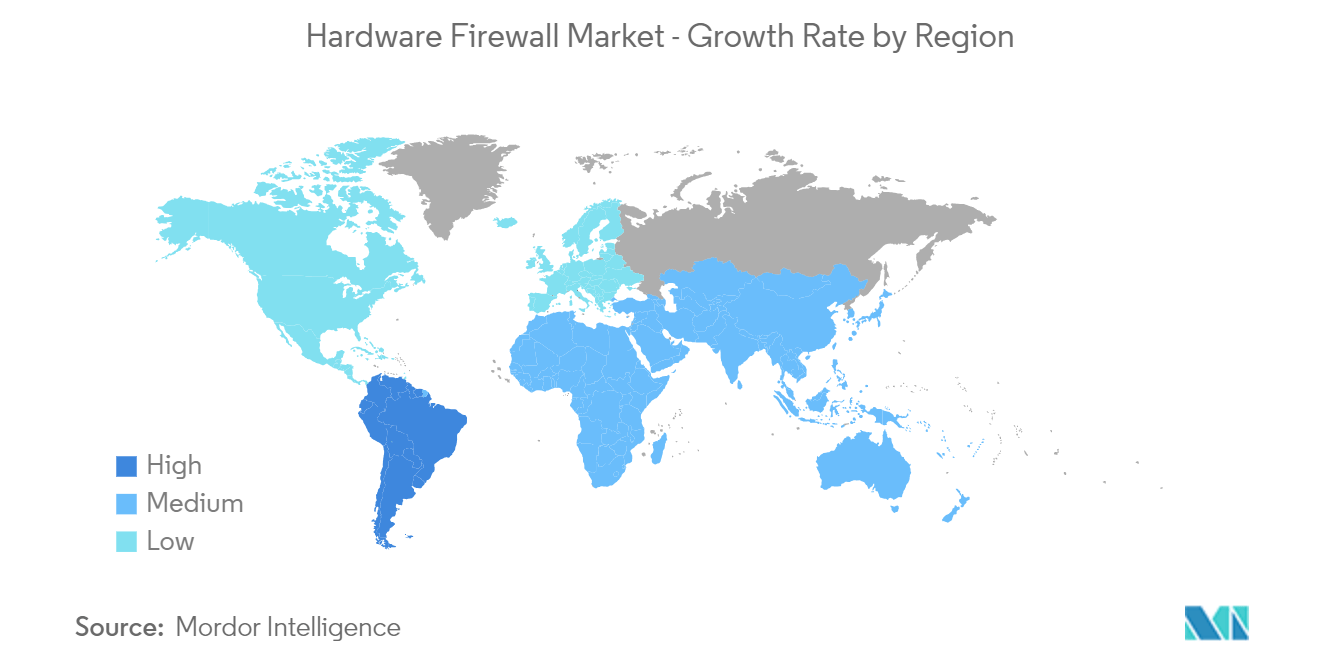
Hardware Firewall Industry Overview
The hardware firewall market is fragmented with the presence of major players like Bitdefender, Cisco Systems Inc., Cujo LLC, Fortinet Inc., and Palo Alto Networks Inc. Players in the market are adopting strategies such as partnerships and acquisitions to enhance their product offerings and gain sustainable competitive advantage.
- June 2024: Tech Mahindra, an Indian IT and consulting firm, strengthened its partnership with US telecom equipment leader Cisco. Together, they aim to deliver advanced next-generation firewall (NGFW) modernization solutions to their global customer base. This collaboration enhances firewall functionalities with features such as unified policy management across both on-premises and cloud environments. Additionally, it incorporates Cisco’s Talos threat intelligence, providing robust malware defense for networks and endpoints.
- April 2024: IBM Cloud and Fortinet strengthened their partnership by launching the Fortinet Virtual FortiGate Security Appliance (vFSA) on IBM Cloud. This new solution from Fortinet combines the powerful features of its FortiGate hardware firewall with the flexibility of virtual appliances. The vFSA provides clients with the advanced security capabilities of FortiGate's next-generation firewall (NGFW) within the IBM Cloud infrastructure. This initiative aims to protect clients' networks, particularly those handling sensitive data, ensuring their continuous high availability.
Hardware Firewall Market Leaders
-
Bitdefender
-
Cisco Systems, Inc.
-
Cujo LLC
-
Fortinet Inc.
-
Palo Alto Networks Inc.
- *Disclaimer: Major Players sorted in no particular order
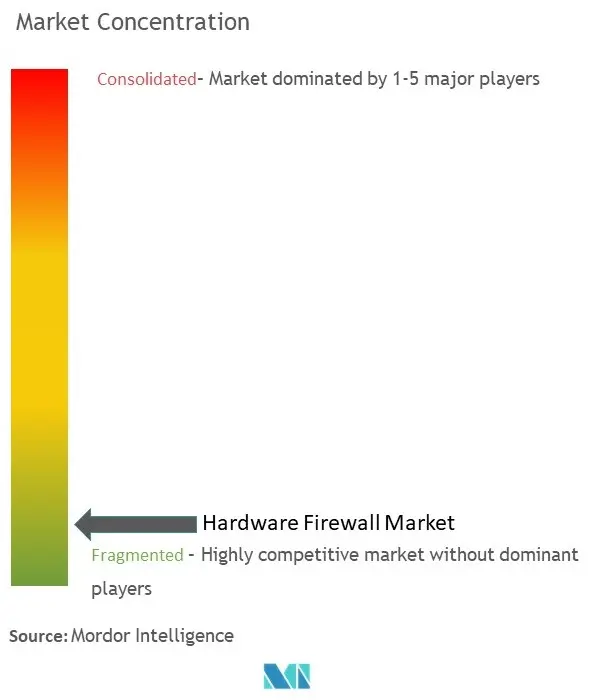
Hardware Firewall Market News
- April 2024: Firewalla launched its cost-effective 10-gigabit smart firewall, designed for next-generation Wi-Fi 7 and high-speed fiber networks. The company specializes in configurable hardware firewalls that connect to routers, providing robust protection for home or business networks against various online threats. The company has announced the pre-sale of Firewalla Gold Pro, the latest and most powerful addition to its "Gold" product line. This device is engineered to be compatible with next-generation Wi-Fi 7 and high-speed 5 and 10-gigabit ISP fiber networks.
- October 2023: Juniper Networks Inc. announced the launch of new firewall appliances and software tools designed to help companies secure their infrastructure. The company expanded its portfolio with four new firewall appliances that can block suspicious traffic in their networks. The hardware portfolio includes SRX1600, SRX2300, SRX4300, and SRX4700, which are powered to scan up to 1.4 terabits of network traffic per second for threats.
Hardware Firewall Industry Segmentation
A firewall hardware, also known as a physical firewall device, is an appliance that fits between the client system and the uplink and filters traffic according to user profiles, security policies, and business rules that have been pre-configured. The uplink transmits traffic from private or public networks to the client system, which can be a server, a WFH system, an employee workstation, or an IoT node.
The hardware firewall market is segmented by component (device/system and services (installation services)), organization size (SMEs and large enterprises), end-user industry (healthcare, manufacturing, government, IT and telecom, and education), and geography (North America, Europe, Asia-Pacific (China, Japan, India, Malaysia, Thailand, Vietnam, Singapore, Philippines, Indonesia, Rest of Asia-Pacific), Middle East and Africa, and Latin America). The market sizes and forecasts are provided in terms of value (USD) for all the segments.
| By Component | Device/System | |
| Services (Installation Services) | ||
| By Organization Size | SMEs | |
| Large Enterprises | ||
| By End-user Industry | Healthcare | |
| Manufacturing | ||
| Government | ||
| IT and Telecom | ||
| Education | ||
| Other End-user Industries | ||
| By Geography | North America | |
| Europe | ||
| Asia-Pacific | China | |
| Japan | ||
| India | ||
| Malaysia | ||
| Thailand | ||
| Vietnam | ||
| Singapore | ||
| Philippines | ||
| Indonesia | ||
| Middle East and Africa | ||
| Latin America |
Hardware Firewall Market Research Faqs
How big is the Hardware Firewall Market?
The Hardware Firewall Market size is expected to reach USD 20.58 billion in 2024 and grow at a CAGR of 11.15% to reach USD 34.92 billion by 2029.
What is the current Hardware Firewall Market size?
In 2024, the Hardware Firewall Market size is expected to reach USD 20.58 billion.
Who are the key players in Hardware Firewall Market?
Bitdefender, Cisco Systems, Inc., Cujo LLC, Fortinet Inc. and Palo Alto Networks Inc. are the major companies operating in the Hardware Firewall Market.
Which is the fastest growing region in Hardware Firewall Market?
Asia Pacific is estimated to grow at the highest CAGR over the forecast period (2024-2029).
Which region has the biggest share in Hardware Firewall Market?
In 2024, the North America accounts for the largest market share in Hardware Firewall Market.
What years does this Hardware Firewall Market cover, and what was the market size in 2023?
In 2023, the Hardware Firewall Market size was estimated at USD 18.29 billion. The report covers the Hardware Firewall Market historical market size for years: 2019, 2020, 2021, 2022 and 2023. The report also forecasts the Hardware Firewall Market size for years: 2024, 2025, 2026, 2027, 2028 and 2029.
Our Best Selling Reports
Hardware Firewall Industry Report
Statistics for the 2024 Hardware Firewall market share, size and revenue growth rate, created by Mordor Intelligence™ Industry Reports. Hardware Firewall analysis includes a market forecast outlook to for 2024 to 2029 and historical overview. Get a sample of this industry analysis as a free report PDF download.




